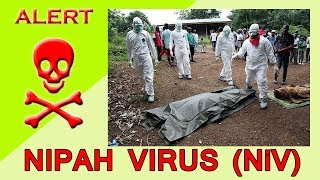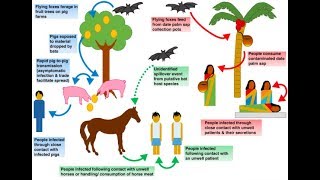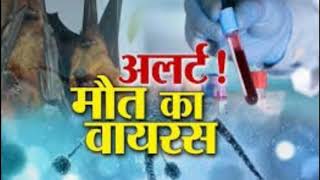Sunday, 14 December, 2025г.
















Где искать: по сайтам Запорожской области, статьи, видео ролики
пример: покупка автомобиля в Запорожье
निपाह वायरस क्या है हिंदी मे जाने | What is Nipah Virus in Hindi | Symptoms, Risk | Learning Guruji
What is Nipah Virus in Hindi | Symptoms, Risks, Treatment, Prevention, Precaution | Learning Guruji
==Nipah virus infection (NiV) is a viral zoonosis caused by Nipah virus of the genus Henipavirus in both animals and humans.[ It was first identified in fruit bats of the Pteropodidae family, which are also the natural hosts of the virus.Out of an estimated 582 human cases of Nipah virus, 54 percent were fatal.
SIGN AND SYMPTOMS:-The symptoms start to appear within 3–14 days after exposure. Initial symptoms are fever, headache, drowsiness followed by disorientation and mental confusion. These symptoms can progress into coma as fast as in 24–48 hours. Encephalitis, inflammation of the brain, is the dreaded complication of nipah virus infection. Respiratory illness can also be present during the early part of the illness. Nipah-case patients who had breathing difficulty are more likely than those without respiratory illness to transmit the virus.
RISKS:-The risk of exposure is high for hospital workers and caretakers of those infected with the virus. In Malaysia and Singapore, Nipah virus infection occurred in those with close contact to infected pigs. In Bangladesh and India, the disease has been linked to consumption of raw date palm sap (toddy) and contact with bats.
DIAGNOSIS:-Laboratory diagnosis of Nipah virus infection is made using real time polymerase chain reaction (RT-PCR) from throat swabs, cerebrospinal fluid, urine and blood analysis during acute and convalescent stages of the disease. IgG and IgM antibody detection can be done after recovery to confirm Nipah virus infection. Immunohistochemistry on tissues collected during autopsy also confirms the disease. Viral RNA can be isolated from the saliva of infected persons.
PREVENTION:-Prevention of Nipah virus infection is important since there is no effective treatment for the disease. The infection can be prevented by avoiding exposure to bats in endemic areas and sick pigs. Drinking of raw palm sap (palm toddy) contaminated by bat excrete, eating of fruits partially consumed by bats and using water from wells infested by bats should be avoided. Bats are known to drink toddy that is collected in open containers, and occasionally urinate in it, which makes it contaminated with the virus.Surveillance and awareness are important for preventing future outbreaks. The association of this disease within reproductive cycle of bats is not well studied. Standard infection control practices should be enforced to prevent nosocomial infections.
TREATMENT:-Currently there is no effective treatment for Nipah virus infection. It is important to practice standard infection control practices and proper barrier nursing techniques to avoid the transmission of the infection from person to person. All suspected cases of Nipah virus infection should be isolated and given intensive supportive care. Ribavirin has been shown effective in in vitro tests, but has not yet been proven effective in humans. Passive immunization using a human monoclonal antibody that targets the Nipah G glycoprotein has been evaluated in the ferret model as post-exposure prophylaxis.The anti-malarial drug chloroquine was shown to block the critical functions needed for maturation of Nipah virus, although no clinical benefit has yet been observed. m102.4, a human monoclonal antibody, has been used in people on a compassionate use basis in Australia and is presently in pre-clinical development.
OUTBREAKS:-Nipah virus outbreaks have been reported in Malaysia, Singapore, Bangladesh and India. The highest mortality due to Nipah virus infection has occurred in Bangladesh. Nipah virus first appeared in Malaysia in 1998 in peninsular Malaysia in pigs and pig farmers. By mid-1999, more than 265 human cases of encephalitis, including 105 deaths, had been reported in Malaysia, and 11 cases of either encephalitis or respiratory illness with one fatality were reported in Singapore.In 2001, Nipah virus was reported from Meherpur District, Bangladesh and Siliguri, India.The outbreak again appeared in 2003, 2004 and 2005 in Naogaon District, Manikganj District, Rajbari District, Faridpur District and Tangail District.
In May 2018, an outbreak has been reported in the Kozhikode district of Kerala, India. Ten deaths have been recorded, including one healthcare worker.Those who have died are mainly from the districts of Kozhikode and Malappuram, including a 31-year-old nurse, who was treating patients infected with the virus. As of 23 May 2018, about 8 people are being quarantined because they had contact with the sick.
For more video Click on the Link and Hit the RED SUBSCRIBE
Button and Bell icon;-https://bit.ly/2wafVFr
Subscribe for free:-
https://www.youtube.com/channel/UCxUXKHC9QR6UDTojPnC6Hvg
Connet with:-
Facebook https://www.facebook.com/LearningGuruji
Twitter https://www.twitter.com/LearningGuruji
Instagram https://www.instagram.com/LearningGuruji
Email id :- [email protected]
Теги:
Learning Guruji learningguruji learning guruji latest video What is Nipah Virus What is Nipah Virus in Hindi निपाह वायरस क्या है निपाह वायरस क्या है हिंदी मे निपाह वायरस क्या है nipah virus kerala nipah virus symptoms nipah virus in hindi kerala news nipah virus study iq nipah virus symptoms tamil nipah virus latest news nipah virus malaysia क्या है निपाह वायरस क्या है निपाह वायरस हिंदी मे निपाह वायरस Nipah virus infection
Похожие видео
Мой аккаунт


 У вашего броузера проблема в совместимости с HTML5
У вашего броузера проблема в совместимости с HTML5


